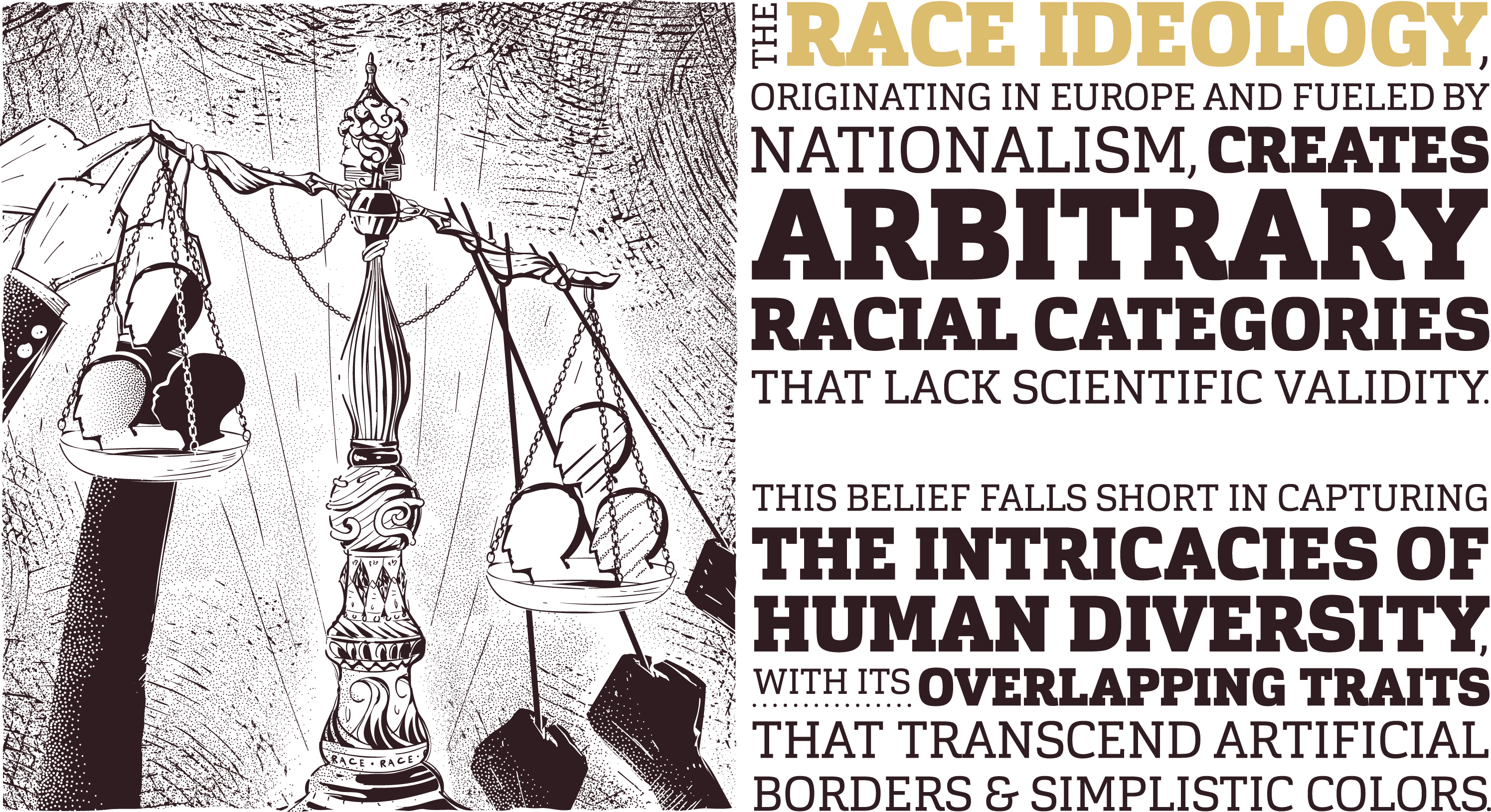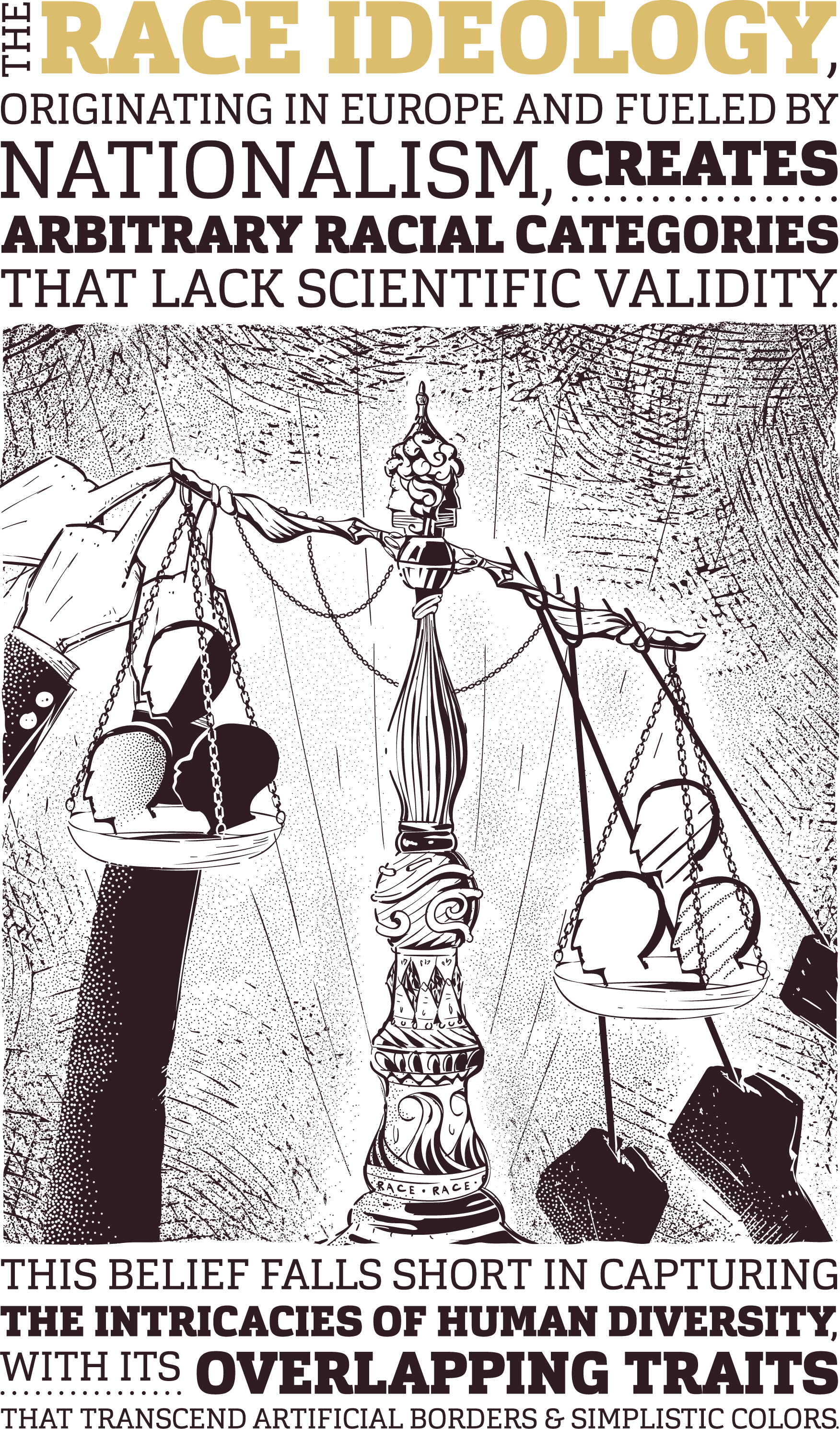
"The story of a little girl, Jihad, facing discrimination because of the name her parents gave her.
Pierce the veil--Unlock the truth--Racism, Nationalism, & Islamophobia, examined through the unbiased lens of scientific inquiry."



The idea of "race" originated in the 18th century when anthropologists used geographical locations and physical traits to divide people into different racial groupings with clear-cut lines. Rather than reflect legitimate and long-established groupings of people who are bound together by their shared history and culture, the concept of “race” is used in an attempt to divide people by their physical traits- like skin, hair, or eye color.
If you were to look at all the people of the world, you would find that the concept of race is completely impractical and incompatible with reality. In fact, no one can even agree on any definitions or distinctions for races. Clearly, physical traits are not clear-cut enough to justify the existence of distinct “races,” so let us take a closer look at the history of humankind’s genes, and our relationship with them.
The problem with using categorization when it comes to human genetics is that our genetics don’t fit into different, neat little categories. Genes spread across the globe like a web. Many traits can’t be traced back to a single origin, because they developed in more than one region completely on their own, not “belonging” to one single place or population.
For example, light skin can be traced back to genes originating from Asia and the Middle East, but it can also be traced to genes that came out of Africa.
A person can be genetically similar to another person while being different in appearance. And two persons that have much in common appearance-wise might share less genetically. That’s because not all genes express themselves outwardly.
People have been constantly moving around the globe for as long as we can tell. Vikings have relocated to North America, Spaniards have moved to Central and South America, North Africans have moved north and Europeans south frequently throughout history. Groups all over the world have roamed around for one reason or another. So not only do we have people with the same types of physical traits originating independently all over the globe, we also have a large amount of these people moving all around, spreading and sharing their specific physical traits.
These historical groups of people we can loosely group by ethnicity, a concept which many people confuse with race. Ethnicity is also an abstract concept of grouping people, but in this case, ethnic groups are held together by a common language and shared culture, rather than physical traits. Because ethnic groups tend to stick together and develop/spread certain traits, these groups can often have common physical traits, too.
But, if they have similar physical traits, why are they considered an ethnicity, and not a race? The idea of race is incompatible with biological reality. The truth is, people cannot be divided into distinct groups with clear-cut lines solely based on their physical traits. Sure, Ireland may have a higher frequency of redheads than many other regions, but redheads aren’t seen as being their own race. Variety not only occurs between groups of people, it occurs within them as well.
As we learned above, our concept of race is clear-cut, even though we as humans are so much more complicated than that. We tend to divide ourselves so distinctly because we have a natural instinct to sort everything in our lives into distinct categories: dark & light, friend & foe, safe & dangerous, etc. Being able to simplify everyone’s diverse traits into categories, and thereby knowing where someone “belongs,” helps our brains manage the overwhelming complexity and diversity of humans.
This is called categorization. Herding dogs do this when out in the field: they don’t recognize the sheep that may need to come in to be sheared or the sheep who’s going to be kept as a breeding ewe, they just see them all like sheep, and since they know that sheep go in a specific place, they herd all the sheep into that specific place. It makes their job simple to see each sheep as part of an entire group, rather than an individual.
In reality, genetics isn’t simple. In fact, we can’t even agree on what defines a race- the definitions of race have changed constantly throughout the centuries, and are even different between every region and country all around the world. We even betray our own constructions of race all the time: if a person’s distinct traits can’t be associated with any existing group, their traits will just be seen as their own personal traits.
We cannot understand race and racism without looking at the influence of nationalism and ideology. The emergence of nationalistic concepts such as “Black Africa” and “White Europe” have had a huge impact on the way racial groups are constructed.
But, while people today may pretend that geographic boundaries somehow distinguish and separate races from each other, in reality, the construction of continent borders has little, if any, to do with phenotypic traits. Historically, lands that now belong to Europe and Africa traded hands so many times between them, it’s clear that the question of their ownership was not about the color of the peoples’ skin who lived on these lands.
Nevertheless, each continent has become associated with a main “racial group,” and has been given the exclusive rights to a certain set of physical traits, despite the fact that these traits also appear on other continents. As mentioned, the theory of race originated in 18th-century Europe under the guise of “science.” Because the Western world was by then seen as the pioneer at the forefront of progress and civilization, the concept of race became swept up in the fervor, becoming a symbol of “modernity.” This benefited Europe, too, because it justified Europe’s colonization of Asia by validating the social superiority of Europeans, as part of the “white” race.
As just one example of how powerful the concept of continents having a specific associated race is, consider the fact that many people still can’t comprehend why the Mediterranean natives of North Africa, the Berbers, have a light skin tone even though they live in Africa – which we think of as the continent of black people. The idea of the widespread existence of “light” people in a region that is supposed to be reigned by “dark” people doesn’t fit into our ideas of race, so to make sense of this, some people have produced a movement called the Black Hebrew Israelites, who claim that the Berber and Egyptian cultures and history have been stolen from them. Instead of just accepting the realities, they crafted their own explanation as a way to keep and reinforce their ideas, rather than be forced to consider that maybe their ideas aren’t completely correct.
The idea of the existence of distinct races which subdivide humanity is so deeply ingrained, some of us are willing to deny historical reality to continue believing in it. Race first gained traction because it gave strength to the notion of European superiority over their colonies, and continues to be a popular concept today, as it can still be used to gain and justify power. It lays the foundation for the belief that some groups of people are naturally superior to others, which has created global power imbalances benefiting some groups over others.
This scenario just illuminates another reason why the concept of race doesn’t fit with reality: if we categorize people by depending on our personal experience with other people, then our definitions of race will be different based on what experiences we have had. The arbitrary and unclear theory of race is not a valid way to divide or define humanity.
Though race may be largely an abstract concept, that doesn't mean that our belief in them doesn’t have real-world influence. Race is still used by some as the motivation for continued discrimination against other groups that are deemed as "inferior.” Instead of maintaining these racial constructions and supporting the misconception that groups of humans can be divided and labeled based solely on skin tones - by using words such as ‘black’, ‘brown’, ‘white’ and ‘yellow’ - we need to spread awareness about the misleading aspects of racialism and the injustices that it produces.




"The story of a little girl, Jihad, facing discrimination because of the name her parents gave her.
Pierce the veil--Unlock the truth--Racism, Nationalism, & Islamophobia, examined through the unbiased lens of scientific inquiry."





